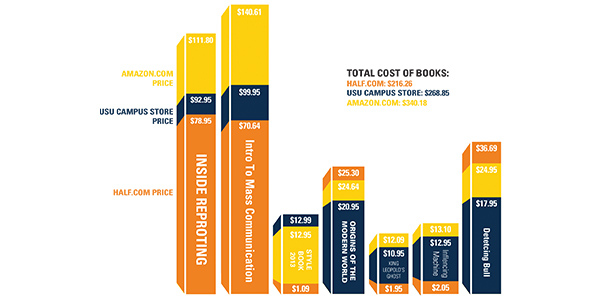Necessary evil
Correction: A previous version of this article quoted a source as having said “medicate” when they said “mitigate.” Please excuse this error.
A freshman girl stood in line at the USU Campus Store, closely followed by anxious parents. They each dropped a heavy stack of books on the cashier’s counter with a thud.
“I’m going to cry when you scan that textbook,” she said, pointing at Paul Krugman’s “Economics.” “I swear, it’s like $170.”
Beep. Yep, $169.99.
“Why do textbooks cost so much?” she asked.
That’s a question students ask every semester. They spend the night in instead of spending $10 on a movie ticket, or skip lunch with their coworkers so they can buy groceries for the week. In a world where college students pinch pennies, why are they willing to pay hundreds of dollars each semester on textbooks?
Even professors know that books are overpriced.
According to the USU Net Price Calculator, students can expect to pay $1,240 annually on textbooks and supplies. Unlike high school, where teachers choose their course materials with an allotted budget in mind (and sometimes with their own money), college professors don’t buy their students’ books.
However, Associate Professor of Economics Alan Stephens said that many faculty members are starting to think their textbooks may be overpriced and are looking for alternatives.
“For example, I allow my students to use past editions, because a lot of time what the authors are doing is just making modest changes to the books, and prices tend to go up,” Stephens said. “So a lot of us look for ways to mitigate that cost.”
This semester, Stephens required “Fundamentals of Corporate Finance” for one of his courses. The retail price is $335, but even a used copy can cost up to $270. An older edition, however, costs only $37.
Vicki Rosen, professor of Biology, said price was a consideration when she chose her course materials, and she gives her students alternatives, as well.
“I would suggest they try to be as creative as possible to minimize the cost,” she said. “Maybe they could share, rent or something else to minimize costs.”
What options do students have?
Unless professors are willing to mitigate the cost of textbooks, it seems it’s up to students to find ways to make textbooks more affordable. (Unless you’re a scholarship-ed student athlete, in which case the university helps you out.)
When it comes to buying their textbooks, students will see on the cashier pad that their total is a whopping $400 or $500 — and then they shrug, figuring, “That’s just part of going to school. Like tuition, it’s just something I have to pay each semester.”
The difference between paying tuition and paying for course materials, however, is tuition finances the university. It’s the oil that keeps the machine running. Tuition is also professors’ salary. It pays for desks, the electricity bill and the pavement — among other things.
And textbook dollars? Those go to publishers. Books are like cars — once they’re in the market, you can sell them cheap from person to person, which is why car prices stay relatively the same. But publishers will make new editions every year or so, which they can sell for much more than an older edition. Professors often require the newest and most expensive edition. Because of this and other reasons the cost of textbooks has increased 812 percent since 1978, more than double the rate of inflation.
While it would take a revolution to turn the textbook market on itself, students can take some control over their finances.
“I would suggest students look for material that’s online,” Stephens said. “A lot of publishers do have online textbooks, but you have to jump some hoops. And if they’re wiling to do that, that’s great.”
Renting textbooks from the USU Campus Store saves hundreds of dollars each semester. Plus, the store only carries the correct editions of books, so it’s very unlikely that students will end up with a Japanese version of “Ecology: Concepts and Applications.” Buyback is more risky, since the campus store will only buyback books if they are in good condition and needed in stock.
Amazon.com carries most textbooks, but there you run the risk of getting the wrong edition. Buying books from Amazon is actually one of the more expensive options, but if you have a Prime membership, your books will be shipped within a few days for free. Buying or renting from other sellers, however, can be very inexpensive.
Half.com, eBay’s textbook-selling site, can be 19 percent cheaper than the USU Campus Store. Shipping and handling costs are about $3.49 per item. Half.com works like eBay, so if a student is looking to sell a book, they can do it on this site as well.
Last year, the university joined Texts.com, a textbook exchange site that allows buying and selling exclusively between USU students. According to the site, it can save students up to 80 percent on their books. However, only two textbooks from an example seven-item book list were available for purchase from other students. The site will only be effective when more student regularly use it, but it has potential. If Amazon is a used car dealership for textbooks, Texts.com is the Craigslist — you may not find what you need, but if you do, you’ll likely get a good deal.
If students don’t mind searching for a while on the USU Book Exchange Facebook group, books tend to be fairly cheap there as well.


Love the plug for texts.com! Great article!
“Medicated” textbooks? Did you mean “mitigate” the cost? Try Chegg.com
Thanks for the correction.